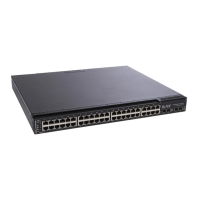© Copyright IBM Corp. 2011 165
Chapter 14. VMready
Virtualization is used to allocate server resources based on logical needs, rather
than on strict physical structure. With appropriate hardware and software support,
servers can be virtualized to host multiple instances of operating systems, known as
virtual machines (VMs). Each VM has its own presence on the network and runs its
own service applications.
Software known as a hypervisor manages the various virtual entities (VEs) that
reside on the host server: VMs, virtual switches, and so on. Depending on the
virtualization solution, a virtualization management server may be used to configure
and manage multiple hypervisors across the network. With some solutions, VMs
can even migrate between host hypervisors, moving to different physical hosts while
maintaining their virtual identity and services.
The IBM Networking OS 6.8 VMready feature supports up to 1024 VEs in a
virtualized data center environment. The switch automatically discovers the VEs
attached to switch ports, and distinguishes between regular VMs, Service Console
Interfaces, and Kernel/Management Interfaces in a VMware
®
environment.
VEs may be placed into VM groups on the switch to define communication
boundaries: VEs in the same VM group may communicate with each other, while
VEs in different groups may not. VM groups also allow for configuring group-level
settings such as virtualization policies and ACLs.
The administrator can also pre-provision VEs by adding their MAC addresses (or
their IPv4 address or VM name in a VMware environment) to a VM group. When a
VE with a pre-provisioned MAC address becomes connected to the switch, the
switch will automatically apply the appropriate group membership configuration.
The G8000 with VMready also detects the migration of VEs across different
hypervisors. As VEs move, the G8000 NMotion
™
feature automatically moves the
appropriate network configuration as well. NMotion gives the switch the ability to
maintain assigned group membership and associated policies, even when a VE
moves to a different port on the switch.
VMready also works with VMware Virtual Center (vCenter) management software.
Connecting with a vCenter allows the G8000 to collect information about more
distant VEs, synchronize switch and VE configuration, and extend migration
properties.
VE Capacity
When VMready is enabled, the switch will automatically discover VEs that reside in
hypervisors directly connected on the switch ports. IBM N/OS 6.8 supports up to
1024 VEs. Once this limit is reached, the switch will reject additional VEs.
Note: In rare situations, the switch may reject new VEs prior to reaching the
supported limit. This can occur when the internal hash corresponding to the
new VE is already in use. If this occurs, change the MAC address of the VE
and retry the operation. The MAC address can usually be changed from the
virtualization management server console (such as the VMware Virtual
Center).

